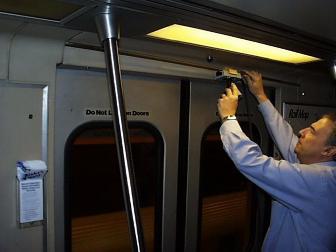Project Results
This project was conducted in two stages. The first stage tested the performance of the Cyclops experimental passenger counting system employing radar and television sensors and a wireless data transmission system. These tests were conducted in the laboratory to demonstrate the feasibility of using each type of sensor to count passengers entering and exiting a simulated wide-stream door located in the laboratory. Each of the two sensor systems (radar and television) were designed to sense passenger presence data independently.
During the second stage of research, radar and television image data were first collected from an operating out-of-service rail transit vehicle to determine if there are vibrational or electromagnetic interference issues that must be addressed and solved. This was followed by full-scale testing of the system on Metropolitan Atlanta Rapid Transit Authority (MARTA) rail rapid transit cars during revenue service. Counting multiple passengers simultaneoulsy entering the wide stream door abreast of each other, shoulder to shoulder, is a challenge for the current radar system design. The Cyclops passenger counter system would need further development to overcome that obstacle before it could provide passenger counts on transit vehicles with wide-stream doors.
Summary of Testing Program
The data produced during testing were used to determine the vibration environment as well as the electromagnetic environment found on a moving rail transit vehicle. Following static testing, operational problem areas were identified and these problems were addressed before tests were conducted on a rail transit vehicle in revenue service.
Processing algorithms were developed in the laboratory after the recorded data were analyzed. The processing system provides the total number of entry and exit events through a wide-stream door at each stop with a time tag.
Product Payoff Potential
The system, when fully developed, may offer transit systems an efficient method of obtaining ridership counts.
Product Transfer
A final report on the Transit IDEA project has been completed. If the passenger counting system can be further developed to overcome the obstacle of multiple passengers simultaneously entering wide stream doors, a commercial prototype system could be developed. This system could be provided to firms in the passenger-counter industry for the purpose of testing to industry standards. Problem areas will need to be corrected during further development. The system design could then be licensed to the passenger counter industry for manufacture and sales to the transit industry.

Figure 1
Passenger Counter being mounted on MARTA rail rapid transit vehicle.
The final report for this IDEA project can be found at:
https://onlinepubs.trb.org/onlinepubs/archive/studies/idea/finalreports/transit/Transit20_Final_Report.pdf.